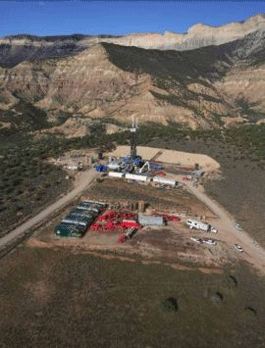Exploration
The section below gives an overview of the exploration activities necessary to locate natural gas resources. Most of the content has been excerpted from Exploration. If you would like more information and far more detail (and pictures!), you are encouraged to consult this source.

"Exploration for natural gas typically begins with geologists examining the surface structure of the earth, and determining areas where it is geologically likely that petroleum or gas deposits might exist. . . . By surveying and mapping the surface and sub-surface characteristics of a certain area, the geologist can extrapolate which areas are most likely to contain a petroleum or natural gas reservoir.
"Seismology, . . . the study of how energy, in the form of seismic waves, moves through the Earth's crust and interacts differently with various types of underground formations, . . . [is also] used to help locate underground fossil fuel formations.
"The basic concept of seismology is quite simple. As the Earth's crust is composed of different layers, each with its own properties, energy (in the form of seismic waves) traveling underground interacts differently with each of these layers. These seismic waves, emitted from a source, will travel through the earth, but also be reflected back toward the source by the different underground layers. Through seismology, geophysicists are able to artificially create vibrations on the surface and record how these vibrations are reflected back to the surface, revealing the properties of the geology beneath.
"An analogy that makes intuitive sense is that of bouncing a rubber ball. A rubber ball that is dropped on concrete will bounce in a much different way than a rubber ball dropped on sand. In the same manner, seismic waves sent underground will reflect off dense layers of rock much differently than extremely porous layers of rock, allowing the geologist to infer from seismic data exactly what layers exist underground and at what depth. While the actual use of seismology in practice is quite a bit more complicated and technical, this basic concept still holds"
Exploration, retrieved February 2014).
Seismology is also used for off-shore exploration, along with other techniques including measuring gravitational and magnetic differences and seismic imaging. Ultimately, the best way to gain a full understanding of subsurface geology and the potential for natural gas deposits to exist in a given area is to drill an exploratory well.
Extraction
To Read Now
Visit NaturalGas.org (Website navigation is a little tricky, so direct links are below):
- Extraction
- Onshore (scan, read if you're interested and have time)
- Shale Shock: Hydraulic Fracturing
- Offshore (scan, read if you're interested and have time)
